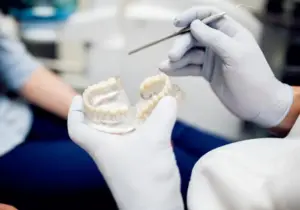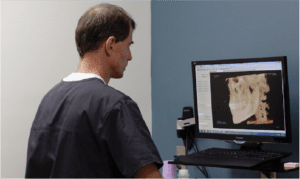The description of tooth roots wrapping around the jawbone involves a bit of poetic license; roots can’t actually go around the jaw bone. This is more of a descriptive term for troublesome tooth roots that are a bit more… meandering than they should be.
Tooth roots sit within the jaw. But sometimes those roots may behave in an unusual manner, or even become fused to the jaw bone. A tooth’s roots can also be longer than usual, whether naturally or due to abnormal growth. Both of these conditions can complicate your oral health and any oral procedures you may have done. Atypical tooth roots can become particularly difficult when extracting a tooth.
In particular, wisdom tooth roots prove to be consistently tricky. The roots attached to all four wisdom teeth are a bit odd and are highly variable in size, shape, and even the number of roots. Naturally, this can cause complications when it comes to removing them.
Extraction Complications with Wayward Tooth Roots
The challenges with a tooth extraction most often involve the roots and their arrangement. For teeth that have multiple roots, such as molars, the root configuration can vary widely from mouth to mouth and from tooth to tooth.
If a molar’s roots have hooks or more curvature than usual, it can complicate the extraction. Removing such teeth may require more force than usual, and that force could break a tooth. All roots are curved, but teeth with extra-curvy roots are more difficult to remove, especially if they’re curved in different directions.
Whether you have meandering wisdom tooth roots or extra-long, extra-curved molar roots, it can be difficult even for a dental surgeon with decades of experience. Troublesome wisdom tooth roots that need to be extracted or wandering roots on other teeth can cause the following problems:
- Root Fractures: Fractures happen especially with roots that are curve or brittle. When the root fractures, it can leave behind fragments that remain buried in the gums.
- Retained Root Fragments: Even with the most precise extractions, small root pieces can be left behind. These can lead to infections, mouth cysts, and pain.
- Damage to Surrounding Areas: Roots that are close to structures like nerves or the sinus cavity can pose challenges when facing extraction. Wisdom teeth can already damage surrounding teeth from the way they come in. If you have abnormal wisdom teeth roots that need removal, don’t delay seeing your local oral surgeon.
- Infection: Intertwined root structures can harbor bacteria, which increases the risk of infection following an extraction.
Dealing with Tooth Roots Tangled in the Jaw
Wisdom teeth roots and jumbled molar roots are typically caught by your dentist on an x-ray or your mouth. The scan reveals the size, shape, and length of the roots in question. It allows the dental surgeon who removes stubborn tooth roots to create a plan of action that makes sense for your individual needs.
One way to deal with this issue is to remove one part of the tooth at a time. We can break a molar into sections, with each section having its own root. This can alleviate some of the issue, as it requires less force to remove a single tooth section than to pull the entire multi-rooted molar at once. This strategy also lets us approach individual roots one-by-one if it is needed. It could be the case that one section of the molar has an unusually curved root, and that section requires attention on its own.
Dealing with one section at a time when a patient presents with tangled tooth roots allows the surgeon to take their time. This reduces the risk of complications like root fragments that break off and get stuck. Working on one part of the tooth at a time is especially helpful when the patient has curved wisdom teeth roots or tooth roots that have a slight hook to them. The dental surgeon performing the extraction has to carefully manipulate hooked or curved roots when operating.
Another potential complication is if the roots are larger than usual. Occasionally, removing a tangled root requires intervention into the jaw bone itself, if piecing out the tooth doesn’t work. Unfortunately, complications with tooth roots almost always mean a bit more invasive of an oral surgery than was at-first planned, whether an impacted wisdom tooth removal or tooth extraction of another kind. Don’t worry; that’s what sedation dentistry and anesthesia are for.
Possible Problems with Wisdom Teeth Roots
Wisdom tooth roots are most often the culprit of root-related complications. Root size comes into consideration when we evaluate a patient for wisdom tooth extraction. Extra-long roots attached to wisdom teeth or wisdom tooth roots that are unusually curved are the kinds that generally pose problems.
We try to extract wisdom teeth when the roots are not fully developed. When the roots are only halfway formed, the wisdom tooth is significantly easier to pull, because it’s not yet fully grown into its place in the jaw. Once it grows into the jaw, not only do the teeth themselves become harder to remove, but so do the wisdom tooth roots. Not fun. Wisdom tooth roots that are stuck pose the following problems for patients:
- Damage to Adjacent Teeth: Wisdom teeth roots that go all over the place have the potential to push against and break down the roots of neighboring teeth.
- Crowding/Misalignment of Other Teeth: Pressure from impacted roots shift other teeth around, causing misalignment.
- Cyst Formation: Roots that crowd around your wisdom teeth harbor bacteria and can lead to formations of cysts and tumors in the mouth.
- Pericoronitis: Pericoronitis is an infection of the gum tissue surrounding the wisdom teeth.
- Nerve Damage: Wisdom teeth roots that need removal can sometimes cause nerve damage. Watch out for feelings of numbness or tingling in the back corners of your mouth.
This is one of the reasons that young people tend to be better candidates for wisdom tooth extraction — their root structures have only grown to 2/3 of their eventual development. This time, when the wisdom teeth begin to emerge but the roots are not yet fully grown, often occurs between the ages of 17 and 25. As a patient ages, the bone surrounding their teeth becomes more dense. This makes it tougher for a wisdom tooth extraction surgeon to remove the teeth and roots. Proactive monitoring of your wisdom teeth when you’re young and have a more malleable mouth is key to preventing unwanted complications from wisdom teeth root removal.
Eye Teeth Have Longer Roots than Other Teeth
Some teeth naturally have longer roots, which make them more prone to impaction and abnormal jaw implantation. Canine teeth, also known as cuspids, have longer roots than other teeth. Cuspids are longer than wisdom tooth roots and others for a couple reasons. The extra-lengthy roots provide better stability and strength to your canines. This is necessary because these are the teeth that we use to tear and rip into food. With such significant force being placed on them, they require a powerful anchor to keep them doing what they do best.
In your upper jaw, these teeth are also referred to as eye teeth. Since these cuspid roots can be longer than those of other teeth, the cuspids can be trickier to extract. If your tooth stays in the jaw bone, however, and does not erupt properly, that is referred to as an impacted or unerupted tooth. Behind wisdom teeth, eye teeth are the most common types of teeth to become impacted. If you have impacted teeth, it’s best to get to an oral surgeon in your area as soon as possible.
While it may require significant force to remove wisdom teeth, it is never necessary to break the jaw during wisdom teeth extraction. Patients will sometimes come to our office believing this to be the case, but it is simply untrue. Extraction of wisdom teeth does not require a jawbone break. What is possible, however, is that the jaw bone can become weakened by the extraction process, progressing for months following the surgery.
If this happens, then there may be an increased chance of bone breakage due to accidents. But the extraction process itself will not break the jaw. Even the most complicated cases of abnormal wisdom teeth roots or impacted tooth extraction would never require such an intervention. Wisdom tooth removal, even the difficult ones, aren’t really that bad. Nothing to be scared of.
Complications with your wisdom teeth roots, eye teeth, or an infected tooth that needs a root canal? For oral surgery procedures in and around Cincinnati and Wilmington Ohio, please contact our office for questions and set up and appointment.









